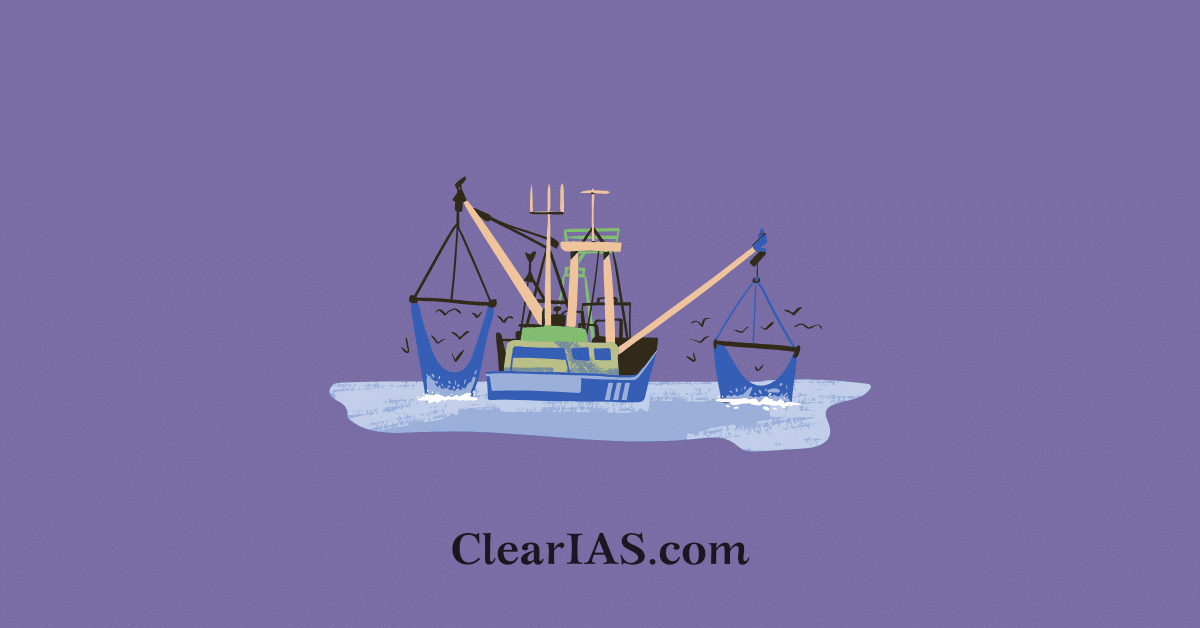
India is ratifying the WTO Agreement on Fisheries Subsidies as a step towards sustainable fisheries. Read here to learn more.
India is in the final stages of ratifying the World Trade Organisation (WTO) Agreement on Fisheries Subsidies, reaffirming its commitment to marine sustainability and the protection of small-scale fishers’ livelihoods.
This development comes at a critical time when the global fishing industry is under pressure from overfishing, illegal fishing, and declining fish stocks, which threaten marine biodiversity and food security for millions worldwide.
What is the WTO Agreement on Fisheries Subsidies?
The WTO Agreement on Fisheries Subsidies is the first multilateral trade agreement focused on ocean governance, adopted at the 12th WTO Ministerial Conference in 2022 (Geneva Package) and entering into force in September 2025, after ratification by two-thirds of WTO members.
Key Objectives
- Curb Harmful Subsidies: End subsidies that drive overfishing and overcapacity.
- Protect Marine Biodiversity: Ensure sustainable exploitation of fish stocks.
- Safeguard Livelihoods: Promote equitable opportunities for millions dependent on fisheries.
- Promote Fair Competition: Reduce trade distortions caused by large, subsidy-heavy industrial fishing nations.
Key Features
- Subsidy Prohibitions:
- Bans subsidies for illegal, unreported, and unregulated (IUU) fishing.
- Prohibits subsidies for the fishing of overfished stocks.
- Bars support for fishing on unregulated high seas.
- Transparency Mechanism: Mandates regular reporting of fishing subsidies and activities to the WTO.
- Implementation Support: The WTO Fisheries Funding Mechanism assists developing countries and LDCs in compliance through technical and financial aid.
- Committee on Fisheries Subsidies: Provides oversight, dialogue, and capacity-building.
India’s Stance and Concerns
India has consistently advocated for a balanced and development-oriented approach that protects the livelihood of its small and artisanal fishers.
- Special & Differential Treatment (S&DT): India demands a 25-year transition period for developing countries and LDCs (compared to 5–7 years proposed by developed countries).
- Per Capita Subsidy Basis: Argues that disciplines must be calculated per fisher, highlighting disparity:
- Developed nations: USD 76,000 per fisher
- India: USD 35 per fisher
- Target Historical Subsidisers: Calls for stricter disciplines on nations that have historically contributed to overcapacity and overfishing.
- Sustainability Focus: Rules should incentivize conservation rather than penalize low-impact developing country fisheries.
India’s Domestic Efforts for Sustainable Fisheries
India is already working to align its fisheries sector with sustainability goals through multiple initiatives:
- Blue Revolution Scheme (2015-16): Boosted fish production, infrastructure, and livelihood security.
- Pradhan Mantri Matsya Sampada Yojana (PMMSY, 2020): Transformative program targeting 8-9% annual growth, sustainable fishing, and job creation.
- Pradhan Mantri Matsya Kisan Samridhi Sah-Yojana (PM-MKSSY, 2023): Formalises the fisheries sector, brings fish farmers into institutional credit, and boosts entrepreneurship. Focus areas: insurance, digital services, value addition, and cluster-based development.
- Fisheries and Aquaculture Infrastructure Development Fund (FIDF, 2018-19): Provides soft loans for port modernization, cold-chain, and fish processing units.
- National Policy on Marine Fisheries (2017): Emphasizes ecosystem-based management and sustainable exploitation within India’s Exclusive Economic Zone (EEZ).
- Marine Fishing Regulation Acts (State-level): Implement fishing bans, seasonal closures, and gear restrictions to prevent overfishing.
- ICAR-CIFE Research & Training: Promotes innovation in aquaculture, seed quality, and climate-resilient fishing practices.
Significance of India’s Ratification
- Global Leadership: Positions India as a responsible stakeholder in global ocean governance.
- Marine Conservation: Supports long-term biodiversity protection and food security.
- Livelihood Security: Advocates for the interests of 9 million small-scale fishers, preventing rules that could marginalize them.
- Trade Benefits: Ensures India remains compliant with WTO norms, avoiding disputes and potential trade penalties.
- Diplomatic Credibility: Strengthens India’s voice in future WTO negotiations on broader trade and environmental issues.
Challenges and Way Forward
- Data Gaps: Need robust, real-time data on fish stock status and subsidy usage.
- Enforcement: Stronger monitoring and surveillance mechanisms to curb IUU fishing.
- Balancing Growth with Conservation: Encourage capacity building for artisanal fishers while preventing overexploitation.
- Regional Cooperation: Work with Indian Ocean Rim nations to adopt joint management of shared fish stocks.
Timeline of Fisheries Sector Development in India
- 1947: At Independence, India’s fish production was 0.75 million tonnes, mostly from inland capture fisheries.
- 1948: Formation of the Central Marine Fisheries Research Institute (CMFRI) to promote marine fisheries research.
- 1957: Launch of the First Five-Year Plan; fisheries recognised as a source of nutrition and employment; establishment of the Central Inland Fisheries Research Institute (CIFRI).
- 1958: Beginning of mechanised fishing; introduction of trawlers on India’s west coast.
- 1961: Establishment of Fish Farmers’ Development Agencies (FFDAs) to promote aquaculture.
- 1965: India becomes a member of the FAO – Indo-Pacific Fisheries Council.
- Late 1960s: Development of mechanised trawling fleets; introduction of purse seine fishing.
1970s: Blue Revolution I
- 1970: Establishment of the Marine Products Export Development Authority (MPEDA).
- 1970: Creation of the Central Institute of Brackishwater Aquaculture (CIBA) for coastal aquaculture development.
- 1971: Launch of the Integrated Fisheries Project for fishing harbours and landing centres.
- 1973: Establishment of the National Institute of Fisheries Post Harvest Technology & Training (NIFPHATT).
- 1974: Creation of the Fisheries Survey of India (FSI) for deep-sea resource assessment.
1980s: Export-Led Growth
- 1981: Setting up of the Fishery Survey of India for systematic resource exploration.
- 1985: Brackishwater Fish Farmers Development Agencies (BFDAs) established to promote shrimp culture.
- 1986–87: First Aquaculture Mission launched for prawn culture—leading to India’s “Prawn Revolution.”
- Late 1980s: India emerges as a leading global shrimp exporter.
1990s: Global Integration
- 1991: Economic liberalisation boosts seafood exports.
- 1995: India signs the WTO Agreement on Agriculture, bringing fisheries into global trade norms.
- 1997–98: National Fisheries Policy focuses on sustainable exploitation of EEZ resources.
2000s: Technological & Policy Push
- 2000: Technology Mission on Fisheries launched to increase productivity.
- 2004: National Fisheries Development Board (NFDB) established for sector-wide coordination.
- 2007–08: Special focus on inland fisheries and reservoir aquaculture under the 11th Five-Year Plan.
2010s: Blue Revolution II
- 2015–16: Launch of the Neel Kranti Mission (Blue Revolution) focusing on integrated development of the sector.
- 2017: National Policy on Marine Fisheries (NPMF) adopted—the first comprehensive marine fisheries policy.
- 2018–19: Establishment of the Fisheries and Aquaculture Infrastructure Development Fund (FIDF).
2020s: Transformation Era
- 2020: Launch of the Pradhan Mantri Matsya Sampada Yojana (PMMSY), a ₹20,050 crore investment to double fish production by 2024–25.
- 2023: Launch of the PM Matsya Kisan Samridhi Sah-Yojana (PM-MKSSY) to formalise fishers and improve credit access.
- 2025: India moves to ratify the WTO Fisheries Subsidies Agreement, aligning domestic policies with global sustainability norms.
- Ongoing: Adoption of digital platforms (e-SANTA), traceability tools, and promotion of mariculture, seaweed farming, ornamental fisheries.
Conclusion
India’s ratification of the WTO Agreement on Fisheries Subsidies reflects a delicate balancing act, committing to global sustainability norms while protecting vulnerable coastal communities.
Going forward, India must combine international diplomacy with domestic reforms, leveraging initiatives like PMMSY and state-level fishing regulations to ensure that blue growth remains inclusive, sustainable, and globally competitive.
Related articles:







Leave a Reply